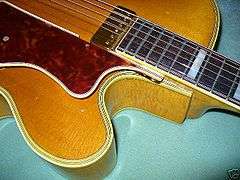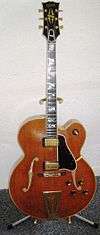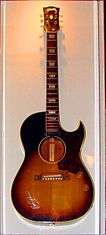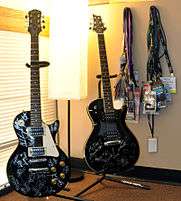Cutaway (guitar)

A cutaway on the guitar construction is an indentation in the upper bout of the guitar body adjacent to the guitar neck, designed to allow easier access to the upper frets.
Overview
Cutaway bodies are mainly of interest when discussing acoustic guitars and semi-acoustic guitars; virtually all solid body guitars either have at least one cutaway, or have a body shape (such as the flying V guitar) which does not intrude into the upper neck area.
Some manufacturers denote instrument models with cutaway using the suffix C, such as the Gibson L5C or the Maton CW80C.
Types


(sharp bout, or pointed cutaway)
on Gibson CF-100E

There are two main types of cutaways: Venetian and Florentine.[1] A Venetian cutaway has a rounded bout. A Florentine cutaway has a sharp bout. The terms probably originate with the Gibson Guitar Corporation and probably do not reflect historic instrument-making practices of Florence and Venice.[2]
A less common third type is the squared-off cutaway, used on the Selmer-Maccaferri guitar and some nylon-string guitars.
Number
Instruments with only a lower cutaway are known as "single cutaway" instruments, and guitars with both are called "double cutaway". These terms are sometimes shortened to "single cut" (such as in the model name for a solidbody electric guitar called the "PRS Singlecut", produced by the Paul Reed Smith company) or "double cut".
Double cutaway

As well as the more common lower cutaway, many instruments have an upper cutaway, sometimes smaller than the lower one, or sometimes about the same size. This is mainly seen on electric guitars, as the reduction in body size resulting from a double cutaway would be detrimental to the sound quality of an acoustic guitar. Double cutaways allow the thumb as well as the fingers to move past the neck-body join. Symmetrical ones also facilitate left-handed use of right-handed instruments.
In some Gibson guitars, models with two cutaways are abbreviated with a "DC" after the name, such as in the Les Paul Studio DC, the Les Paul Standard DC, the Les Paul Special DC, and the Les Paul Junior DC. Since more single cut versions of these guitars are produced than the doublecut versions, if the model name of these guitars is not followed by "DC", "double cut", or "double cutaway", the assumed reference is to the single cutaway models.
References
- ↑ Mottola, R.M. (Fall 2009). "Parametric Models of Guitar Cutaways". American Lutherie (99): 60.
- ↑ "Cutaway Terms". Q & A. Acoustic Guitar magazine. October 2002. Archived from the original on 2012-09-13."Q: Can you explain the origins of the terms Venetian cutaway and Florentine cutaway? —Robert Manzoni / A: Venetian and Florentine refer to the actual shape of the cutaway: Venetian describes the rounded cutaway and Florentine the sharp, pointed form. The original use of these terms can be traced to early Gibson nomenclature in advertising material and catalogs. ...there isn't any evidence that these cutaway styles actually came from Venice or Florence. ... —Ian Watchorn"
| Wikimedia Commons has media related to Cutaway (guitar). |


%2C_PRS_Custom_(1988)_-_MIM_PHX.jpg)
%2C_Museum_of_Making_Music.jpg)
